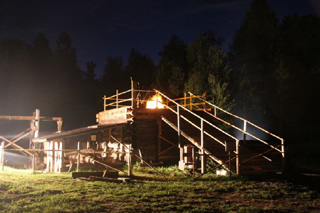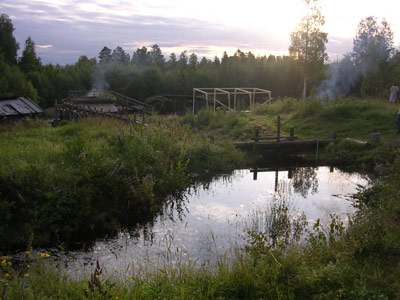 |
The reconstructed medieval industrial iron production site at “Nya Lapphyttan” in Norberg is based on the results from an archeological excavation of Lapphyttan just outside of Norberg. The excavation was performed during the end of 1980 and some results have been presented at different international conferences.The original site (Lapphyttan) is one of the first proofs of the development of a new, more economical, way of producing malleable iron or steel in Europe. It has been dated to the early medival era with its origins from the 12:th centrury. The archeological excavation has shown ironmaking using the indirect route from iron ore, via pig iron from a blast furnace, to produce malleable iron or steel in a finery hearth. |
|
|
The reconstruction consists of the following facilities: - a water dam, a water wheel and bellows of leather to produce the cold blast air. - a blast furnace with a concept based on results from the archeological excavation together with descriptions of the “old swedish blast furnace” found in literature from the early 1800-century. - a roasting pit for the ore treatment - charcoal storage facility - two finery hearths with leather bellows - reconstructed medieval buildings The reconstruction in Norberg is one of its kind and probably the only place in the world where actual, full scale trials of medieval ironmaking using a blast furnace and finery hearths can be performed.
In 2004 a non-profit association “Järnet på Lapphyttan” (The iron of Lapphyttan) was formed with the aim to create an understanding of the initial development of ironmaking through the indirect route during the middle ages but also to get better understanding of the knowledge of the people working with this new technology and their working conditions. The association arranges workshops and exhibitions and organizes the work during the experimental work at the reconstruction at Nya Lapphyttan. In “Järnet på Lapphyttan” we have access to the reconstruction at Nya Lapphyttan giving us the possibility to perform experimental work in both the blast furnace and in the finery hearths. Many archeological excavations has shown the principle layouts of an medieval industrial site for iron production but the more precise and important details regarding furnace design, raw material and operation to actually produce the right products is far from known. In “Järnet på Lapphyttan” we actively work with developing the facilities in the reconstruction and performing experiments under medieval conditions. Based on the evaluations of trials, what is found in the literature and new information from archeologists/metallurgists we make changes in furnace design, raw materials or operation parameters and perform new experiments. The experimental work until now has learned us a lot but that there are still more to learn before we fully understand the conditions to control and operate a medieval blast furnace in a proper way. Regarding refining pig iron to malleable iron or steel in a finery hearth we have only performed some initial tests but plan to work more with this during this and coming years. In the autumn of 2010 a first successful trial in the finery hearth was performed. Preparation for experimental medieval iron production 2015 in going on. | |
| |
|
| |
|
| |
Besökare sedan 20050627:
|

